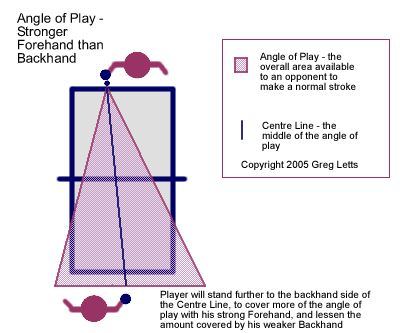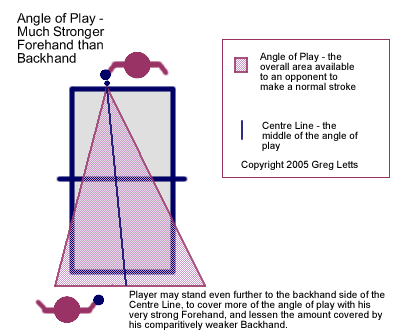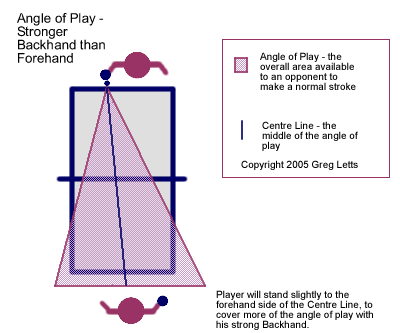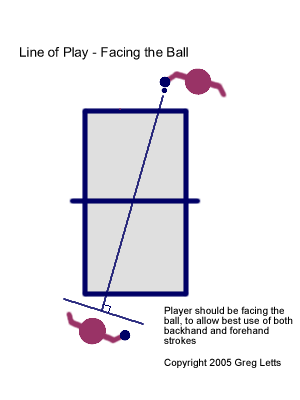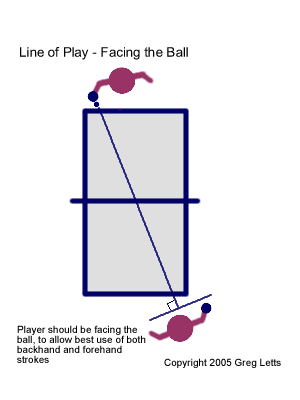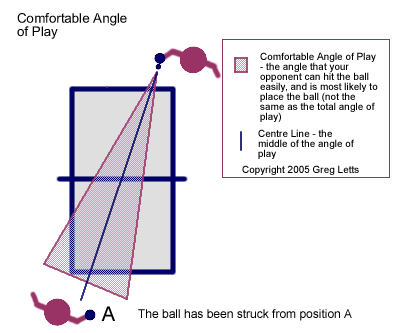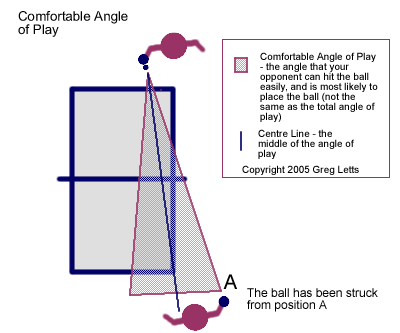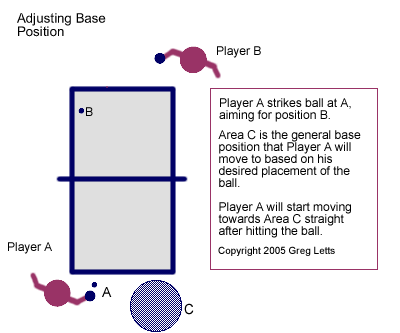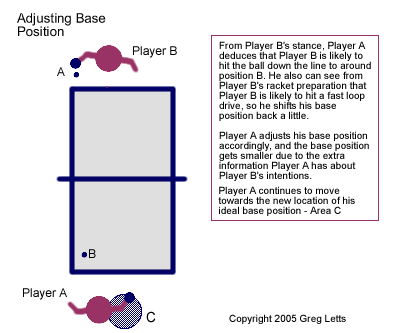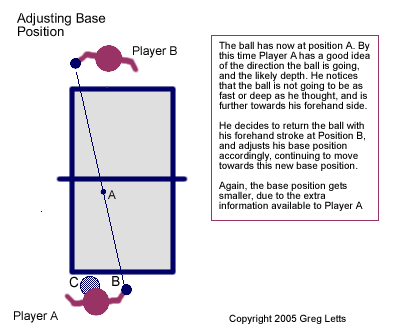Back to Base-ics

Positioning yourself on the court during a rally
Sunday, January 1, 2006
by Greg Letts - an Australian state coach, an International Umpire and one of the top ranked players in his country.
In this article I'm going to put down some thoughts for those table tennis players out there who have mastered the basic techniques of the sport and are looking for other areas in which to improve their game.
In particular, I'm going to talk about the subject of base positioning in table tennis. By this I mean the skill of positioning yourself on the court during a rally so that you can play your best table tennis.
Why Base Positioning?
Yes, it's a bit of a strange name, I know. But I like to think of this skill as base-positioning because it reminds me of the base-camps used in Artic expeditions or mountain climbing. A base-camp is used as a safe starting point from which explorers or climbers go to more dangerous territory. In table tennis, your base position is the place on the court that gives you the best chance of coping with your opponent's upcoming stroke, and from which you can move as needed to reach the ball.
Base Positioning - Basic(!) Concepts
Stay neutral
In general, it's a good idea to adopt a ready position and stance that allows you to play both forehand and backhand with ease. I'm not going to go into huge amounts of detail about this in this particular article, but here's a quick summary of what to do.
For righthanders, keep your feet either square to the line of play (see further below for an explanation of line of play) or the right foot a little bit behind the left foot. Keep the feet wide apart - typically a fair bit wider than shoulder width - check out the professionals in action for examples of just how wide they go. You should be crouching forward a little, and your elbows will be roughly shoulder width apart, with the tip of the bat pointing forward. I'll talk a little more below about where exactly to point the tip of the bat. The basic idea is that it should be easy to hit both forehand and backhand from this position - the forehand by simply turning the shoulders to the right, and the backhand by rotating the forearm 90 degrees towards your torso.
What's your angle?
Everybody has got an angle, so they say. This is true in table tennis as well as in life, and it is a good idea to know what your angle is.
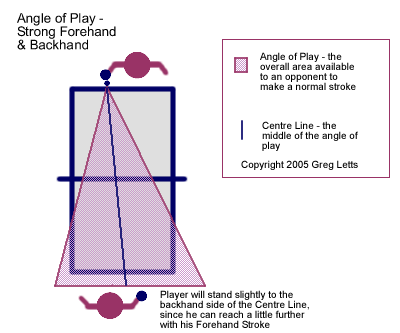
How do you do this? Let's imagine a right-handed player with a forehand and backhand that are equally strong. In his case, he should stand in the middle of the range of angles available to his opponent (this range of angles is called the angle of play). But since he can reach a little further with his forehand than his backhand, he probably should stand a half-step or so to his left to take advantage of this fact. Players with strong forehands and backhands, such as Waldner or Schlager, will tend to stand in this area. |
|
|
|
So take a look at the relative strength of your forehand and backhand strokes, and position yourself accordingly. Remember, if you improve one side without improving the other, your base position should change as well. Don't still be standing in the middle of the angle of play if your forehand is twice as good as your backhand!
Face the ball - not the endline
|
|
Don't point your bat at the ball
Assuming you are right handed, your bat should actually be pointing somewhere between one foot to one and a half feet to the right of the ball, not straight at the ball. Why is this? Because if you are facing the ball, your bat is actually one to one and a half feet to the right of your body when you are standing ready and keeping yourself able to go to the forehand or backhand equally easily. So if you point your bat directly at the ball, you will actually be in a slightly backhand waiting position.
Base Position - Advanced Concepts
Your Base Position will change
During a rally, your base position will change a number of times. This can be due to a number of factors, such as:
What stroke you are about to play
What stroke you just played
Where you put the ball on the table
What angle you hit the ball from
What shot your opponent is likely to play
You might have noticed that of these factors, only one of them actually relates to your opponent. So in fact you have a lot of control over where your base position will be. Let's have a look at these factors one by one.
What stroke you are about to play
On the forehand side, most strokes are played from pretty much the same position relative to your body - a little to the side. But on the backhand, this can be different. Backhand pushes and counters close to the table are usually best performed directly in front of your torso. As you move back from the table, backhand drives, loops and chops tend to be better if you take them a little more to the side of your body. This can and will affect where your base position should be, in terms of sideways positioning.
What stroke you have just played
The stroke you have just made will also affect your positioning, but in a more up and back manner. If you have just made a strong attack or tight push or chop, you will probably want to come closer to the table, or hold your position. If you have made a weak shot, you may wish to retreat from the table a little.
Where you put the ball on the table
This can have an effect in two ways. Firstly, where you put the ball on the table will help determine what distance away from the table your opponent hits the ball, which can then affect whether you should be coming in close to the table or moving back.
Secondly, if you can put the ball in places that are difficult for the opponent, such as wide angles or into his crossover point, you are more likely to get a weak return, and as such you should be coming closer to the table or holding position, looking for another powerful followup attack.
What angle you have hit the ball from
The angle you have hit the ball from will affect the way that your opponent is facing. As such, different parts of the table will be within his comfortable range of angles. The accompanying picture shows a ball hit by you from your backhand side, to the opponent's backhand side. Note the comfortable range of angles that your opponent can hit from this position (Note - the comfortable range of angles is simply the area that your opponent will find it physically easiest to hit the ball, and thus most players are more likely to put the ball in this range). |
|
What shot your opponent is likely to play
The stroke that your opponent is likely to play is in part influenced by his own positioning, strengths and weaknesses, and in part by the return you have given him and your own positioning during the rally. The best place to put yourself will change depending on how these various factors interact.
For example, if your opponent has a strong forehand loop crosscourt, but is not so good at hitting down the line, you could adjust for this by standing a little further to your right, knowing that he is not as likely to hit down the line during rallies. Or if he is strong at looping off pushes but tends to block topspin returns, you may wish to go back a little when pushing, then come forward when you reloop his first attack. An opponent who prefers to run around his backhand to hit off-forehands to your backhand may require you to move to your left when he runs around his backhand to attack, but come back to the right if you can survive his first attack and put it wide to his forehand, giving you a chance to pin him down on his backhand side.
Another point to note is that if you can force your opponent to play a certain stroke or a certain direction consistently, you can adjust your base position accordingly. For example, if you have a good deep sidespin serve to your opponent's backhand that your opponent is finding difficult to return down the line, you can stand further to your left when waiting for his return of service. By cutting down his available options, you can get away with standing in a position that would be suicidal if he was flipping the ball down the line easily.
Always move towards your best base position
|
|
|
Remember, it is better to take one small step towards your best base location, than to simply stand still after hitting your last shot. Even the smallest of steps in the right direction will improve your chances of getting to the next stroke. So don't ever stop and wait, unless you believe you are already in the right place!
© 2005-2025 Greg Letts
You may also read Greg's blog and purchase Australian TT videos from Greg's own website


